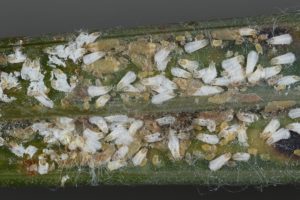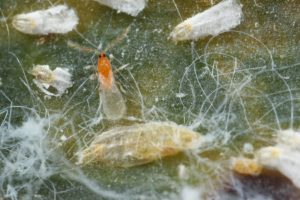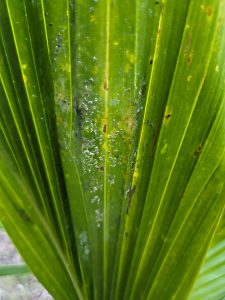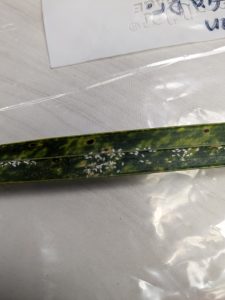Background
In 2024, a new scale has been introduced into Collier County: the Phantasma scale (Fiorinia phantasma). It was originally discovered on the east coast of Florida in Miami-Dade county in 2018 and is a serious pest of ornamental plants such as Ligustrums and all palm trees in the Arecaceae family. There have been a few sightings of this scale on Foxtails palms and Ligustrums throughout Naples. When feeding on palm leaves and other ornamental plants, they will be present not only on the bottom of the leaves, but also on the surface.

Just like other armored scales the females have a waxy protective covering that makes it difficult to chemically control with contact insecticides. The adult males are red/orange in color and look like small gnats as seen in the picture below, but you will need a 10x hand lense to see them.

The size of the adult females are similar to that of tea scales which is also in the same Genus, but the females of Phantasma scales will be lighter in color. Phantasma scales can be transported from plant to plant through wind, cutting instruments, infected leaf tissue, and animals. The first stage or instar are the crawlers which appear yellow in color and are the most vulnerable to biological and chemical control. These crawlers are six legged, highly mobile, and have no protective covering. In small infestations, palm leaves may appear to have small white “spots” on them. During heavy infestations, the entire leaf may covered in scales and appear to have a white hue similar to that of powdery mildew. The first signs that the Phantasma scale is present on ornamental plants and palms are yellow, chlorotic patches on the leaves as seen below. This may cause the leaves or fronds to wilt and prematurely fall off the plant.


Control Measures
As in every Integrated Pest Management scenario, proper identification is the first step. If you are not sure if your plant has the Phantasma scale, bring a sample in a sealed container to your local UF/IFAS extension. Always assess the pest pressure before deciding on a control measure. If there are only a few leaves or branches that are infested with Phantasma scale, it may be better to trim off the infected portions and soak them in soapy water before disposing. If the infestation is more severe, choose a chemical treatment that will be the least environmentally impactful while still providing control for the pest. As for biological control, lady beetles, lacewings, and parasitoid wasps have been found to attack Phantasma scale. Chemical products that have been shown to be effective on controlling Phantasma scale are listed in the Mid-Florida Research and Education Center (MREC) publication in the resources section. When buying and installing new plants and palms in the landscape, be sure to inspect the entire plant for this scale.
If you are unsure if you have the Phantasma scale in your landscape, or need help with control measures, reach out to your local UF/IFAS extension agent.
Resources on Phantasma Scale and Control
Chemical control MREC: https://mrec.ifas.ufl.edu/lso/PHANTASMA/pdf/Phantasma-Management.pdf
Pest alert: https://ccmedia.fdacs.gov/content/download/79840/file/pest_alert_-_fiorinia_phantasma.pdf
Field guide for diagnosing this scale: https://mrec.ifas.ufl.edu/media/mrecifasufledu/pdfs-and-excel/Phantasma-new-field-guide.pdf
More details on this scale: https://florida-environmental.com/phantasma-scale/
 3
3
